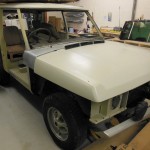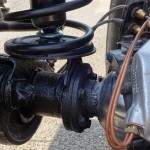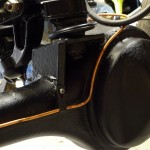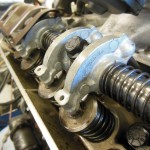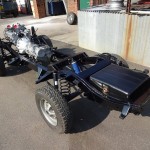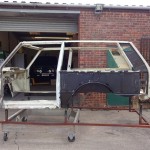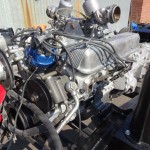Not content with a comprehensive and highly detailed restoration of Velar chassis number 10, Famous Four have recently taken on another very early ‘Classic’ Range Rover restoration; chassis number 48, registration ELA 830J.
ELA 830J was the third vehicle to leave the production line in Solihull, and was supplied directly to the Ministry of Technology along with two other Range Rovers, chassis numbered 53 and 54, which were consecutively registered as ELA 831J and ELA 832J. The former was painted in Sahara Dust and the two latter were Masai Red. All three vehicles are extremely important in the history of the Range Rover development.
ELA 830J subsequently became the first ever Range Rover to be evaluated as an ambulance, was displayed as such at Farnborough airshow in 1970, and served for many years with the MoD at Boscombe Down, having been lightly modified by Wadham Stringer to accommodate a single personnel stretcher.
Released by the Ministry in 1985, ELA 830J passed through the Bristol & West Motor Auction group to its new owner, Burnworthy Manor in the Blackdown Hills in Somerset; within 10 days of purchase it was painted in military camouflage colours and was used as part of a high octane military style leisure sport business named ‘Combat Zone’ which operated in the country estate in the 1980s and 1990s. Occasionally it was used to ferry wounded combat players to Musgrove Park Hospital in Taunton suffering severe cuts that needed stitches!
Burnworthy Manor sold ELA 830J on in 1991, and by 1998 it had fallen in to a rather sad (but not unusual for a Classic Range Rover) state of disrepair; body corrosion had worked its way into the frame, and its future hung in the balance. Luckily, its historical importance was recognised, and Brian and Phil Bashall of Dunsfold Land Rovers bought the wreck, with to a view to either save it or as a donor of many rare and unobtainable super-early Suffix A parts.
It was during a trip to DLR’s Surrey premises that Dr. Julian Lamb, now of Aston University, spotted the vehicle’s potential, and bravely undertook its restoration back to a fully road-going vehicle, whilst diligently preserving its originality and painstakingly researching its past life. He and his wife used ELA 830J as a ‘daily driver’ for some years, exhibiting it at the NEC Classic Car Show in 2000. During their ownership ELA 830J was reunited with Charles Spencer ‘Spen’ King, the original designer of the Range Rover, and unique and previously unseen video footage now exists of CSK himself driving the vehicle.
The vehicle has not been on the road since the late 2000s as Dr. Lamb began a full strip down with a view to complete restoration, before deciding that time constraints meant he could not dedicate the effort required to complete the project to the level he felt it deserved an required.
Famous Four were delighted to have the opportunity to acquire the Range Rover from Dr. Lamb early in 2015 and immediately have begun the process of thorough restoration; the body has been removed from the chassis; the chassis has been shot blasted and powder coated; the running gear has been overhauled and re-fitted to the now rolling chassis, and the bodywork is being professionally restored prior to a full refit.
Further updates will appear on our website blog, and we very much hope to be exhibiting ELA 830J on our stand at the 2015 NEC Classic Car Show.
It is hoped that by 2016 chassis number 48 will be re-built to a high standard ready for the next chapter in its colourful life, and will take its place as one of the most historically important ‘Classic’ Range Rovers in the long and successful lineage of the model stretching back over 45 years.
We will be updating you with the progress of our thorough Range Rover restorations over the coming months and years, as we return it to its original incarnation as one of the most historically important Range Rovers still in existence, and as such a hugely important vehicle in the long and successful history of the Range Rover marque.
- ELA 830J as it arrived with us earlier in 2015
- Attention to detail in running gear
- Attention to detail in running gear
- Engine receives some light TLC
- Rolling Chassis
- Body shell, removed and ready for restoration
- Clean, tidy engine

